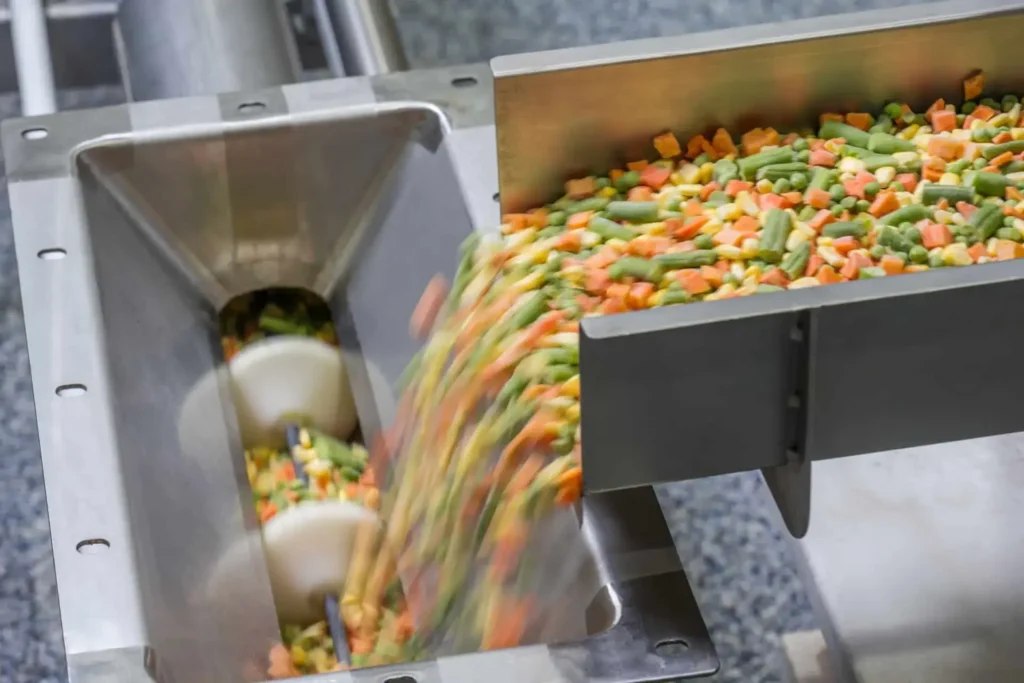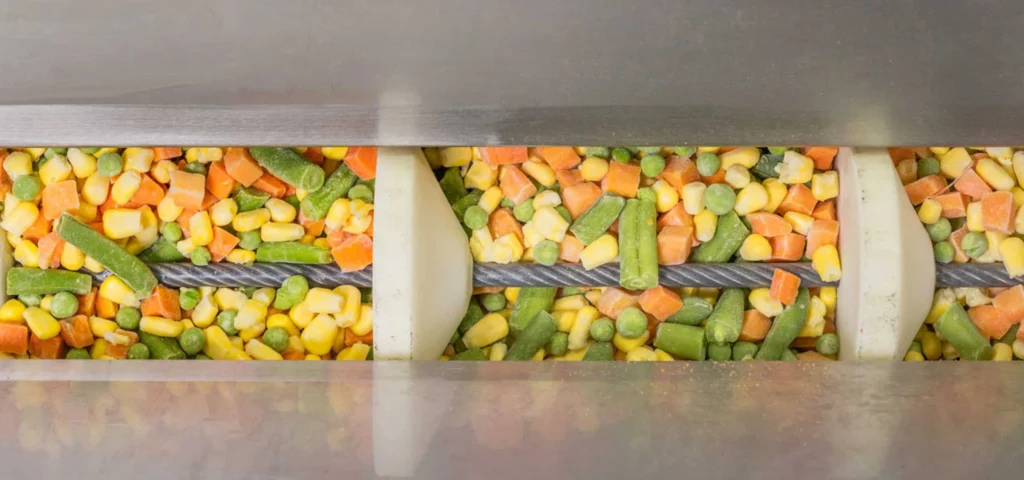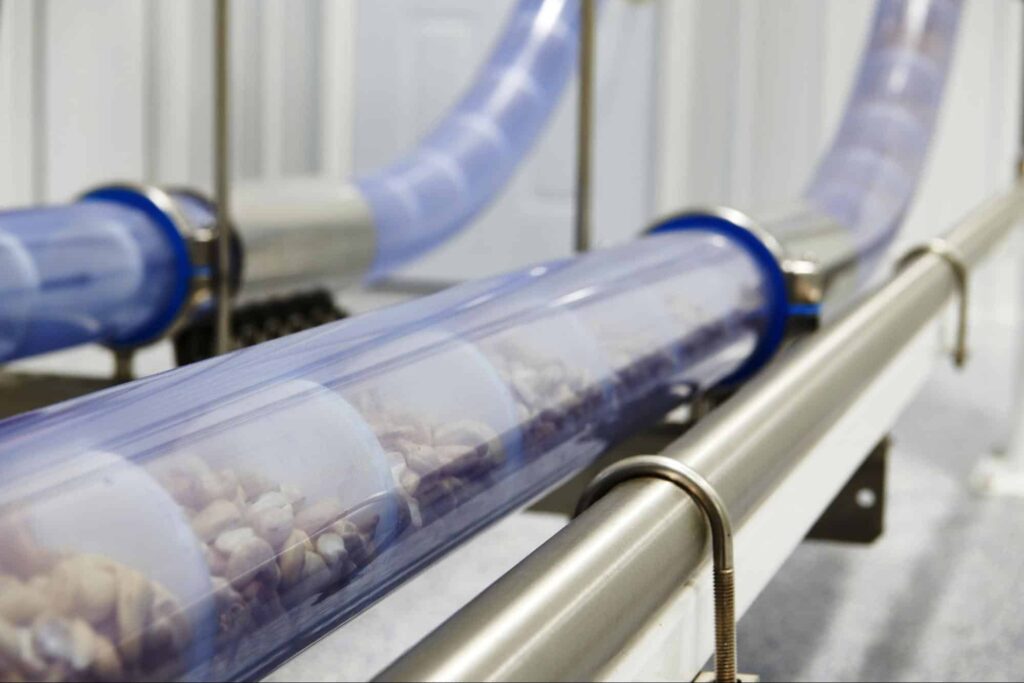It is common knowledge that the food processing industry has to maintain a high level of cleanliness. This is necessary to avoid food contamination and spread of diseases. Automated conveyor systems are the right equipment for this. We’ll answer here why are stainless steel conveyors ideal for food processing. We will delve deeper into this topic and expand on how some conveyors can eliminate these issues.
Conveyors play a vital role in transporting materials from one point to another in food processing facilities. Before the advent of conveyors, manual labor was needed to transport food items from one area to another, which was not only time-consuming but also posed a high risk of contamination. Conveyors eliminated this problem by allowing food to be moved quickly and efficiently without human contact.
What Is Stainless Steel?
Stainless steel is an alloy of iron. It contains about 11% chromium but also carbon and small amounts of silicon, manganese, phosphorus, and sulfur. What makes stainless steel special are its properties – it is strong, durable, and, most importantly, resistant to rust and corrosion.
Difference Between Regular Steel and Stainless Steel
When exposed to oxygen, regular steel (also known as carbon steel) will rust. The iron in the steel reacts with the oxygen in the air to form iron oxide, also known as rust. Rust is not only unsightly, but it can also cause structural damage to a steel object. Rusty surfaces are porous, flaky, and weak. Also, they can easily crumble.
Stainless steel, on the other hand, does not rust thanks to the chromium in it. When oxygen comes into contact with the surface of stainless steel, the chromium forms an outer layer of chromium oxide. This layer is very thin and invisible to the naked eye, but it protects the underlying steel from rust and corrosion. This property of stainless steel makes it ideal for the pharmaceutical, food, and beverage industries, where cleanliness and sanitation are of utmost importance.

Benefits of Stainless Steel Conveyors
Corrosion resistance is imperative in the food processing industry, where conveyor belt systems are constantly exposed to water, steam, and other cleaning agents. If the system is not corrosion-resistant, it will degrade quickly and need to be replaced more often, which can be costly in the long run. But these conveyors have a lot more to offer than just being corrosion-resistant. Let’s discuss more benefits of solid stainless steel conveyors.
No Product Contamination
A dirty, rusty, or corroded belt conveyor system can cause product contamination. This is a serious issue in the food processing industry as it can lead to foodborne illnesses. The World Health Organization (WHO) estimates that every year around 600 million people (1 in 10) fall ill after consuming contaminated food. And of those, 420,000 die. Food contamination that originates from food processing and material handling equipment is not only a health hazard but also results in:
- Product recalls,
- Production shutdowns,
- Legal action.
Business can be brought to a standstill, and the company’s reputation can be tarnished. Fortunately, stainless steel food conveyor lowers the risk of food contamination because they are durable and non-porous.
Other materials, such as rubber and plastic, can degrade over time and are more susceptible to physical damage than stainless steel. They release particles that find their way into the food product and become a source of contamination. On the other hand, stainless steel is a strong and durable material that does not degrade easily, making it less likely to release contaminants.
A porous surface has tiny holes or cracks in it. These holes can capture bacteria and other contaminants, which can then be transferred to the food product. Stainless steel is a non-porous material, which means that it does not have any tiny holes or cracks that could potentially harbor contaminants.
Difference Between Contamination and Cross-Contamination
It is important to differentiate contamination from cross-contamination. Contamination occurs when there is a foreign substance present in the food product. Cross-contamination, on the other hand, happens when bacteria or other contaminants are transferred from one food product to another.
For example, if raw chicken juices come into contact with cooked chicken, the cooked chicken is now contaminated. If those same raw chicken juices were to come into contact with salad, the salad would be cross-contaminated. A thoughtfully designed automated conveyor system can help reduce the risk of both contamination and cross-contamination.

Easy to Clean and Sanitize
Another important consideration in the food industry is cleanliness. Conveyors in food processing plants must be easy to clean and sanitize to prevent the spread of bacteria and ensure food safety.
Stainless steel is the material of choice because it can withstand harsh cleaning agents and high temperatures. Due to the strict sanitation requirements in the industry, conveyors are often exposed to high-pressure water jets and steam. Other materials, such as rubber and plastic, can degrade over time when continually exposed to these and other cleaning agents.
However, stainless steel is highly resistant and can withstand repeated exposure to high temperatures, making it ideal for use in food processing applications. Pair them with an efficient mechanism for cleaning conveyor belts, such as these clean-in-place systems, and you have a conveyor system that can be effectively and quickly cleaned.
Preserves Food Flavor
You’re probably familiar with the process of outgassing – when a material releases gasses that can change the flavor of food. This is a common issue with rubber conveyor belts because they often contain sulfur.
When the belt comes into contact with food, the sulfur can be released and contaminate the food product, changing its flavor. Stainless steel does not outgas, making it an excellent choice for conveying food products that are sensitive to flavor changes.
Resistance to High Temperatures
In many food processing applications, conveyors need to be able to withstand extreme temperatures. For example, when meat is cooked, it needs to be transported quickly to the cooling area to prevent bacteria from growing.
If the conveyor is not heat-resistant, it can be subject to degradation, which can lead to contamination. Stainless steel conveyors can withstand high temperatures, making them ideal for use in food processing facilities where cooked food is transported.
Resistance to Low Temperatures as Well
Of course, not all food needs to be cooked. Some foods, such as frozen fruits and vegetables, must be kept at low temperatures. If a conveyor is not resistant to low temperatures, it can break down, leading to costly repairs. If your facility specializes in frozen food, stainless steel conveyors are a good option, as they can withstand low temperatures without breaking down.

Is Stainless Steel Really the Best for All Food Processing Applications?
No material is perfect, and there are some drawbacks to using stainless steel conveyor equipment in food processing facilities. The biggest drawback can be noticed when materials that contain natural oils, such as peanuts and tree nuts are transported.
Natural oils can adversely affect stainless steel, slowing down the conveying process and leading to a dip in production. If your facility processes food that contains natural oils, you may want to consider using a conveyor made of another material, such as a food-grade polymer.
Bear in Mind the Cost of Stainless Steel Conveyor Systems
Stainless steel can be pretty costly. If you’re working with a tight budget, you may want to consider using a more affordable material. Plastic or rubber conveyors can be a more cost-effective option, even if they don’t have all the benefits of stainless steel.
When making design decisions for your food-grade conveyor, weigh the pros and cons of each option to make the best decision for your facility. Don’t forget about factors such as budget, production needs, and the types of products you’ll be conveying. With a little bit of research, find the perfect material for your food processing conveyor and the perfect conveyor systems manufacturers.
Choose the Ideal Option For Your Requirements
Because of its unique properties, stainless steel has been the material of choice for many food processing processes, including material conveying. It is resistant to high and low temperatures, does not outgas, and is easy to clean. The risk of product contamination is greatly reduced when using stainless steel conveyors, making them a safe and reliable option for conveying food products. But remember, it can be costly and is not ideal for conveying food that contains natural oils.
When deciding which material to use during the conveyor design process, consider the needs of your facility and the products you’ll be transporting. Don’t lose sight of the hygiene and safety concerns that are inherent in the food processing industry.
To learn more about choosing the right conveyor for your food processing facility, contact us at Cablevey Conveyors. We specialize in gentle material handling solutions that are designed to meet the unique needs of the food processing industry. Our experienced team can help you choose the right conveyor for your facility and provide more info on a tubular conveying system, as well as expert conveyor installation supervision and maintenance services.






